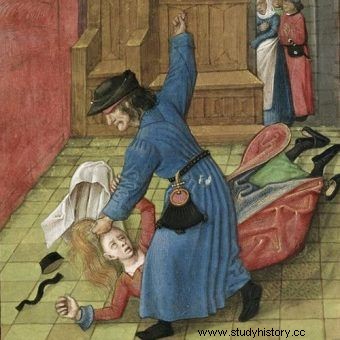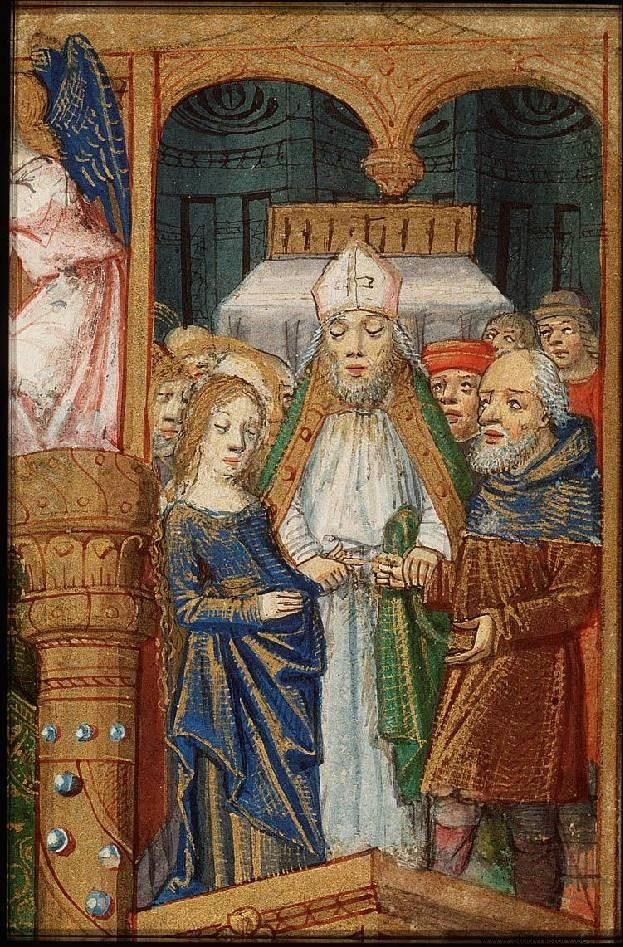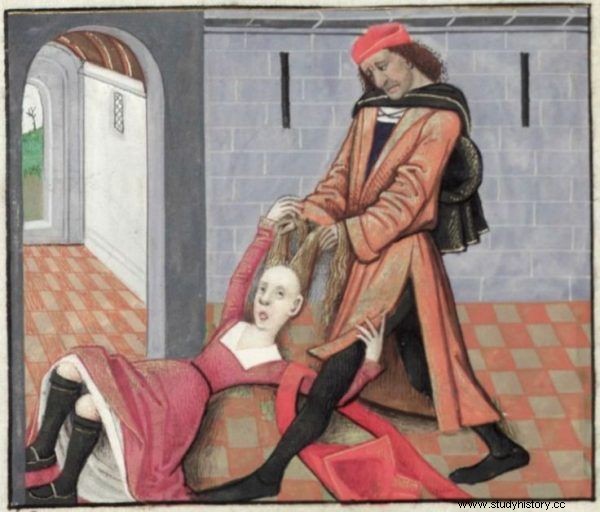According to the Germanic tradition, rape was one of the three obligatory forms of marriage. Even the Church was getting used to the idea that every kidnapped and abused girl should be forced to marry the torturer.
If a man kidnaps a woman, he must not be allowed to marry her, church experts said throughout almost the entire early Middle Ages. The matter was on their heart, because such stories happened frequently.
The feudal, bathed in hot water, but deprived of funds and proper status, ambushed the desired lady, abducted her and dragged her to the altar. Sometimes, even before the forced wedding, he raped the spouse, thus depriving the girl of her honor, value in the eyes of her family and the hope that she would be able to return home and marry another candidate.

Abused woman. Miniature from the codex of late medieval Bruges
The Germanic tradition even said that rape was one of the three forms of marriage. Marriage could be contracted according to custom, so obtain family consent, deliver the dowry, and observe all ceremonies. However, it was also possible to persuade the chosen one to flee or - to kidnap her by force and possess, thus depriving both the woman and her relatives of any possibility of preventing the relationship.
Forcing raped to marry
Various jurists wrote about the kidnappings. The fact that the matter has been revisited for centuries only confirms that the phenomenon has not disappeared, and perhaps even grew stronger. Marriage by rape was not committed only by sadistic desperates, but also by calculating wretches dreaming about the property owned by the widow of a wealthy landowner or about the titles inherited by a spotted bride.

The altar ceremony was only one of the three traditional forms of wedding
If something changed, it was the scale of the protest. Church law experts have become accustomed to the problem. And gradually they raised fewer and fewer objections. Iwo of Chartres, an outstanding French canonist who composed at the turn of the 11th and 12th centuries, finally made a 180-degree volt. He concluded that in the event of a kidnapping, not only should the marriage not be refused, but indeed… both parties must be forced to formalize an already consummated relationship!
Good rape because it's for the money
Other wise heads may not go that far, but also - they no longer defend the right of women (or at least their families) to decide about their future. Gratian of Bologna, often called the father of canon law, stated in the 12th century that as long as the raped and incapacitated lady is able to obtain consent and the kidnapper performs the prescribed penance, there is no need to block the marriage.
Stefan of Tournai, who created at the same time, only made a reservation that it was appropriate to analyze the grounds for the rape. If a man used force to obtain temporary sexual pleasure, he was considered a mere degenerate and sinner, and therefore did not deserve the hand of the abductee. However, if from the beginning he was motivated by the desire to marry a woman, then he should be treated with great understanding.
It is the woman who has to prove that she resisted
The provisions of the marriage law introduced at the beginning of the 13th century by Pope Innocent III were maintained in a similar vein. Its paragraphs, however, did not close the discussion at all. In the fourteenth century, abductions were still debated, often requiring the woman to prove that she had fiercely resisted the rape and thus - signaled that she was reluctant to marry a potential kidnapper.

Kidnapping of a woman on a French miniature from the end of the 15th century
Apart from ecclesiastical authorities, the phenomenon was also dealt with by secular jurists. Kidnapping appears in various legal fictions, usually as a serious crime. At the same time, however, it is not an act that threatens with death, banishment or mutilation. As a rule, lawmakers are content with high fines, partly transferred to the victim's family. Thus, the procedure gains silent approval provided that it is pursued by wealthy enough people.
A procedure known to Poles
Poles also know the problem. For example, the statutes introduced by King Kazimierz refer to the kidnappings. However, it is not a particularly restrictive law. The ruler assumes that the kidnapping of the family's daughter requires private revenge, and asks only to limit her to the perpetrator himself and not to start civil wars because of a minor incident.
The method of gaining a wife by force is known also in Mazovia. This method is practiced there especially often, which leads to bloody skirmishes between families. Local princes are trying to curb the phenomenon. However, not all of them. Because Siemowit IV, ruling since 1381, decides to ... be inspired by it.
Peak of the insolence
Europe at the end of the fourteenth century knew cases of kidnapping even very high-born and well-connected women. In England, it happened, for example, that a group of thugs led by one Jack Irish kidnapped a wealthy widow and landowner, Lady Maud de Clifford. She was taken prisoner as she traveled with an entourage through Yorkshire. And there is no doubt that the gang leader wanted to marry her and thus quickly climb the rungs of the social ladder.

A distressed woman in a medieval miniature
However, it is one thing to kidnap a countess or a widow of the mayor, and another - a real princess. Such stories did not happen. The thirty-year-old Siemowit, who had just taken over a part of the Mazovian district from his deceased father, did not mind, however, that he would become a pioneer. In 1383 he saw himself kidnapping not even the princess, but ... the king's daughter herself.
The Polish elite was just waiting for Jadwiga to come to the country :the younger of the two offspring of the late Ludwik Węgierski , after long negotiations, appointed as the new ruler of Poland. The girl is not yet ten years old. Despite this, Siemowit wanted to kidnap her and force her to marry. And at the same time:to put Poles in front of a fait accompli and to secure the royal crown for himself.
Selected bibliography:
The article was based on materials collected by the author during the work on the book "Ladies of the Polish Empire. The Women Who Built a Power " . Some of these items are shown below. Full bibliography in the book.
- Brundage J.A., Law, Sex, and Christian Society in Medieval Europe , The University of Chicago Press, Chicago – London 1990.
- Dunn C., Stolen Women in Medieval England. Rape, Abduction and Adultery, 1100-1500 , Cambridge University Press, Cambridge - New York 2013.
- Krawiec A., Sexuality in Medieval Poland , Poznań Publishing House, Poznań 2000.
- Palczewski M., The fight of Siemowit IV for the throne of Poland (1382–1385) , "Scientific works of the Pedagogical University in Częstochowa. Historical Notebooks ”, vol. 1 (1993).
- Wilamowski M., Siemowit IV [in:] The Piasts. Biographical Lexicon , edited by K. Ożóg, S. Szczur, Wydawnictwo Literackie, Krakow 1999.
- Women and Gender in Medieval Europe. An Encyclopedia , eds. M. Schaus, Routledge, New York-London 2006.
